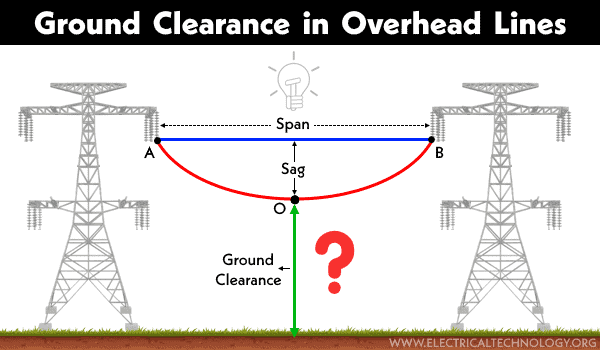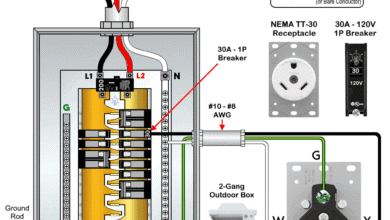What is the Minimum Ground Clearance for Overhead Power Line?
Minimum Ground Clearance Standard of Sag
Due to safety reasons, an adequate distance is always maintained between the overhead conductor and the ground, depending on the transmission or distribution voltage. The distance between the ground and the loaded conductor (overhead power line) is known as conductor-to-ground clearance or simply ground clearance.
The minimum distances specified for ground clearance due to sag in transmission and distribution power lines in any country are referred to as ground clearance standards. These standards depend on factors such as conductor material, line construction, line spacing, ground position, supporting structures (e.g., poles, towers, and insulators), and, especially, weathering effects.
As a general rule of thumb, the minimum ground clearance for 33 kV overhead lines is 6.1 meters (20 feet). In cases where the voltage exceeds 33 kV, an additional clearance of 0.30448 meters (one foot) is considered standard for every 33 kV.
How to Calculate the Ground Clearance?
Despite the rule of thumb, you may use the following given tables to calculate the ground clearance for overhead power lines in difference cases.
Example 1:
What is the suitable ground clearance for 132 kV overhead line?
Solution: In the case of 132 kV line, the minimum ground clearance is as follows:
132 kV = 33 kV + 3 x 33 kV
Ground Clearance = 6.1 + 3 × 0.3048 = 6.1 + 0.91
G.C = 7 meters (≈ 23 ft.)
Example 2:
Find the appropriate ground clearance for 220 kV power lines.
Solution: Using the tables, ground clearance for 220 kV overhead transmission line will be as follows.
220 kV = 33 kV + 187
220 kV = 33 + 33 × 5.67
Ground Clearance = 6.1 + (0.3048) × 5.67
G.C = 7.8 meters ((≈ 25.6 ft.)
Ground Clearance Tables
The following tables illustrate the ground clearance for overhead lines in various scenarios.
Table 1 – Maximum Clearance above Ground of the Lowest Conductor of an Overhead Line
| Ground Clearance | ||||
| S.No. | Voltage | When erected across a street | When erected along a street | When erected elsewhere than across or along any street |
| 1 | Low & Medium Voltage Lines | 5.8 m (19 ft.) | 5.5 m (18 ft.) | 4.6 m (15 ft.) – (For bare conductor) |
| 2 | High Voltage Lines up to 11 kV | 6.1 m (20 ft.) | 5.8 m (19 ft.) | 4 m (13 ft.) – (For insulated conductor) |
| 3 | High Voltage Lines up to 11 kV | ….. | ….. | 5.2 m (17 ft.) |
| 4 | High Voltage Lines up to 33 kV | ….. | ….. | 6.1 m (20 ft.) |
Table 2 – Minimum Clearance between Conductors and Trolley Wires when an Overhead Line is crossing a Tramway of Trolley Bus Route.
| S.No. | Voltage | Clearance |
| 1 | Low & Medium Voltage Lines | (a) 1.22 m (4 ft.) for bare conductor
(b) 0.61 m (2 ft.) for insulated conductor |
| 2 | High Voltage Lines up to 11 kV | 1.83 m (6 ft.) |
| 3 | High Voltage Lines above 11 kV | 2.44 m (8 ft.) |
| 4 | Extra High Voltage Lines | 3.05 m (10 ft.) |
Table 3 – Minimum Clearance from the accessible point on building of the Low Table and Medium Voltage Lines and Service Lines, when the Line passes above or adjacent to the building.
| Type of Roof | Voltage | Clearance |
| Flat Roof | 2.44 m (8 ft.) – From the highest point | 1.22 m (4 ft.) |
| Pitched Roof | 2.44 m (8 ft.) – Immediately below the lines | 1.22 m (4 ft.) |
Table 4 – Minimum Clearance from any accessible point on building of High and Extra-High Voltage Lines, when the Line passes above or adjacent to the building.
| S.No. | Voltage | Vertical clearance above the highest point on the basis of maximum sag | Horizontal Clearance on the basis of maximum deflection due to wind pressure |
| 1 | High Voltage Lines up to 11 kV | 3.66 m (12 ft.) | 1.22 m (4 ft.) |
| 2 | High Voltage Lines above 11 kV & up to 33 kV | ….. | 1.83 m (6 ft.) |
| 3 | Extra High Voltage Lines | 3.66 m (12 ft.) + 0.305 m (1 ft.) for every additional 33 kV or part thereof. | 1.83 m (6 ft.) + 0.305 m (1 ft.) for every additional 33 kV or part thereof. |
Related Posts:
- Why is the Ground Wire Always Positioned Above the Overhead Power Lines?
- What is the Purpose of Ground Wire in Overhead Transmission Lines?
- Why are Overhead Power Transmission Lines Not Insulated?
- Why is the Grounding Wire Bare and Not Insulated?
- How Many Poles and Towers are Situated Within a 1-km Span?
- Why are Overhead Power Lines Loose on Electric Poles & Towers?
- Difference Between Grounding, Earthing and Bonding
- Difference Between Real Ground and Virtual Ground
- What is the Difference Between Neutral, Ground and Earth?
- Comparison Between Overhead & Underground Transmission Systems
- Why are Salt and Charcoal Added in Earthing Pit for Grounding?
- Why are Stones Used in an Electrical Substation?
- What are the Effects of Temperature on Sag in Overhead Lines?
- Skin Effect and Factors Affecting Skin Effect in Power Lines
- Ferranti Effect in Power Lines – Causes, Advantages & Disadvantages
- Corona Effect & Discharge in Transmission Lines & Power System







